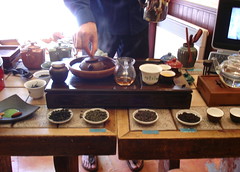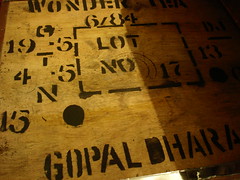Spring Tea Annual 2006
 fig. a: Hugo brings us the world of Taiwanese tea
fig. a: Hugo brings us the world of Taiwanese tea
Have a cuppa tea, have a cuppa tea,
have a cuppa tea, have a cuppa tea,
Halleluja, halleluja, halleluja, Rosie Lea
Halleluja, halleluja, halleluja, Rosie Lea
--"Have a Cuppa Tea," The Kinks
Today was the day of our tea tasting session at Camellia Sinensis, the day their resident connoisseurs unveiled the discoveries they'd brought back from their respective sourcing trips to the orient this spring. The good people at Camellia Sinensis have been the city's reigning experts on tea since 1998, and they've been sourcing and importing their fine offerings all the while, but over the years their contacts and their knowledge of the Asian tea market have grown considerably and their ability to locate the most interesting teas available and bring them back in saleable quantities has also improved. The result is that their shop--already the best in town, and on par with the best just about anywhere in the western world--has gotten even better over the years, and their tastings and tea workshops have matured accordingly.
Over the course of 2+ hours this morning, we were escorted on a virtual voyage from India to China to Japan and finally to Taiwan in order to sample some of the best teas on offer this year from each region. We sampled quite a number of teas during this period--16 or so--but nowhere near the 900-1,000 teas one might try over a week of tasting in one of the world's great tea-growing regions. Every region had its highlights, but, in my opinion, the two most interesting presentations were those on India and Taiwan, as it was there that we came across the biggest surprises. Of course, this probably says something about my own biases when it comes to teas.
Shocking as this may seem, there was no tea cultivation in India before the British began cultivating it there, creating their tea plantation system in the process. The success of this experiment should be obvious to anyone who knows anything about tea: the British were successfully cultivating high quality teas at low prices within 50 years and India now produces 80% of the world's black tea, the type of tea most commonly consumed in the west. In the 18th and 19th centuries, the British made numerous attempts to tap into the vast Chinese market while simultaneously breaking the lockhold the Chinese had on certain commodities. These tensions resulted in not one but two Opium Wars; they also resulted in the establishment of industrial tea production in India. Famously, the British developed a new strain of tea plant in the Indian highlands (Assamica), one discovered in the wild by Charles and Robert Bruce of the East India Company, and they took advantage of its less finicky leaf in order to revolutionize tea production. In addition to making his rounds in search of the finest teas he could find in Darjeeling and Assam this spring, Kevin, our India expert, also set out to trace the very roots (quite literally) of tea production in India. He's yet to publish his findings--keep your eyes open for his article in Tea Almanac later this year--but I can assure you he made some fascinating discoveries. As for the teas he offered us, there's no question that the most impressive was the first one we sampled, the fair-trade, organic Darjeeling Samabeong DJ-1. The Samabeong is grown in some of the very highest tea gardens in the world--the highest, according to Kevin, although there seemed to be a bit of an in-store competition going on over this claim--and not only is it the finest Darjeeling I've ever come across, it also has the uncanny ability to withstand the usually detrimental effects of a long steeping period. It was just as good at the end of the tasting as it had been at the beginning--different, for sure, but just as good--and Kevin claimed that it was a tea of such quality that you could brew a pot and drink half of it before going to bed and the remaining half would still be excellent the next morning, if not piping-hot any longer. My other favorite from our India segment was the unusual organic Darjeeling Gopaldhara DJ-13, a tea that actually belongs to the oolong family and has since become known as "Wonder Tea," although others in our group seemed to prefer the more traditional Darjeeling Margaret's Hope DJ-35 which hails from one of the oldest tea gardens in India.
 fig. b: a crate of Gopaldhara, a.k.a. "Wonder Tea"
fig. b: a crate of Gopaldhara, a.k.a. "Wonder Tea"
Our seminars on China and Japan were not without their moments--the light, delicate flavor of the Huiming H1 from China and the rich flavor and elaborate, if abbreviated, ceremony that surrounded the Japanese Macha Wako among them--but as I mentioned, it was some of the Taiwanese selections that we tasted and our in-depth discussion of the elaborate process used in grilling green tea leaves in order to make a fine oolong that really left an impression. For the most part, oolong tea production has changed drastically since the days when the leaves were cooked over charcoal fires for anything from minutes to hours--sometimes repeatedly over a period of years--most producers now using an elaborate system of electrical machinery to reach a similar result, but the process is still enormously time- and labor-intensive. And the nature of oolong--the fact that the leaves are grilled and that in many cases they're grilled then aged then grilled again--means that it's one of the only types of teas that can age and mature, virtually every other tea being best consumed fresh. The first Taiwanese oolong we tried was a young Pinglin Bao Zhong that had extraordinary floral and fruit overtones to it (magnolia and peach, in particular). The Si Ji Chun 2 was also a young tea, but one with a robust flavor with overtones of tire d'érable due to the way the leaves were gently caramelized during its production. The aged Cingshin from 1991 was easily one of my top two teas of the entire event: exceptionally smooth, with light caramel notes to it.
If you haven't yet been to Camellia Sinensis and you're interested in discovering some of the finest and most unusual teas the world has to offer, you really owe yourself a visit. If you're looking to develop a deeper appreciation of tea, there's no better or more pleasant way to do it in Montreal than through one of their tea tastings or workshops.
Camellia Sinensis, 351 Emery, 286-4002
http://camellia-sinensis.com/
aj








3 comments:
Great summary of the tea tasting event at Camellia Sinensis. I'm with you on the Samabeong DJ-1, it's awesome, however, what about that Ambootia DJ-36?!? Holy moly!, that was unlike any Darjeeling I've ever had. It was so smooth and malty. I can understand why even wine and whiskey tasters are interested in that one.
Hi Marc-A,
Yeah, you're right the Ambootia was also something else. After I finished writing my post Michelle and I were discussing the future of tea. It seems El Bulli has recently introduced tea pairings with their dishes much in the same way that restaurants have recommended wine pairings for years now. The Ambootia was one of the teas that came to mind because with a tea of its character it's easy to imagine taking things even further and creating a tea + spirit combination to go along with a dish (I'm thinking a dessert at the moment).
Thanks for reading.
Gopaldhara 1st flush -
Pure Joy! I must added.
Post a Comment